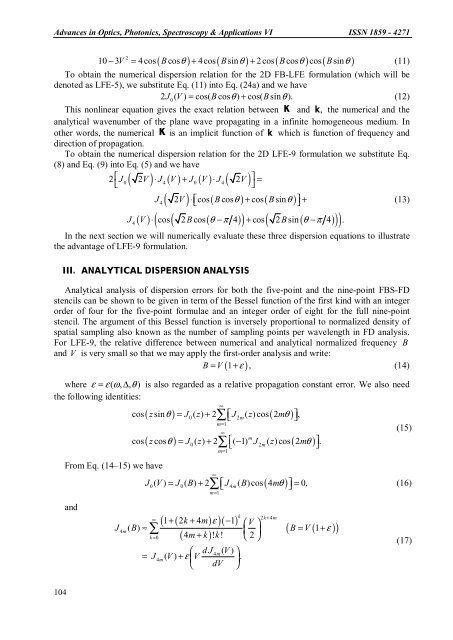Nhng tin b trong Quang hc, Quang ph và ng dng VI ISSN 1859 - 4271
Nhng tin b trong Quang hc, Quang ph và ng dng VI ISSN 1859 - 4271
Nhng tin b trong Quang hc, Quang ph và ng dng VI ISSN 1859 - 4271
You also want an ePaper? Increase the reach of your titles
YUMPU automatically turns print PDFs into web optimized ePapers that Google loves.
Advances in Optics, Photonics, Spectroscopy & Applications <strong>VI</strong> <strong>ISSN</strong> <strong>1859</strong> - <strong>4271</strong>( θ ) ( θ ) ( θ ) ( θ )210 − 3V = 4cos B cos + 4cos Bsin + 2cos B cos cos B sin(11)To obtain the numerical dispersion relation for the 2D FB-LFE formulation (which will bedenoted as LFE-5), we substitute Eq. (11) into Eq. (24a) and we have2 J0( V ) = cos( B cos θ) + cos( B sin θ ).(12)This nonlinear equation gives the exact relation between κ and k , the numerical and theanalytical wavenumber of the plane wave propaga<s<stro<strong>ng</strong>>tro<strong>ng</strong></stro<strong>ng</strong>>>tin</s<stro<strong>ng</strong>>tro<strong>ng</strong></stro<strong>ng</strong>>>g in a infinite homogeneous medium. Inother words, the numerical κ is an implicit function of k which is function of frequency anddirection of propagation.To obtain the numerical dispersion relation for the 2D LFE-9 formulation we substitute Eq.(8) and Eq. (9) into Eq. (5) and we have( ) ⋅ ( ) + ( ) ⋅ ( )⎤ =⎦J4 ( 2V ) ⋅ ⎣⎡cos( B cosθ) + cos( B sinθ) ⎦⎤+J4 ( V ) ⋅ ( B ( θ − π )) + ( B ( θ −π))2 ⎡J 02V J4V J0 V J42V⎣( )cos 2 cos 4 cos 2 sin 4 .In the next section we will numerically evaluate these three dispersion equations to illustratethe advantage of LFE-9 formulation.III. ANALYTICAL DISPERSION ANALYSISAnalytical analysis of dispersion errors for both the five-point and the nine-point FBS-FDstencils can be shown to be given in term of the Bessel function of the first kind with an integerorder of four for the five-point formulae and an integer order of eight for the full nine-pointstencil. The argument of this Bessel function is inversely proportional to normalized density ofspatial sampli<strong>ng</strong> also known as the number of sampli<strong>ng</strong> points per wavele<strong>ng</strong>th in FD analysis.For LFE-9, the relative difference between numerical and analytical normalized frequency Band V is very small so that we may apply the first-order analysis and write:B = V 1 + ε ,(14)( )where ε = ε ( ω, ∆ , θ ) is also regarded as a relative propagation constant error. We also needthe followi<strong>ng</strong> identities:From Eq. (14–15) we haveand( z θ ) J z J z ( mθ)cos sin = ( ) + 2 ⎡⎣( ) cos 2 ⎤⎦,∞∑0 2mm=1∞∑m( z θ ) = J z + ⎡ − J z ( mθ)cos cos ( ) 2 ⎣( 1) ( ) cos 2 ⎤⎦.0 2mm=10 0 4m=1∞(13)(15)∑ ⎡m ( ) ⎤(16)J ( V ) = J ( B) + 2 ⎣J ( B)cos 4mθ⎦ = 0,( 1 ( 2 4 ) ε )( 1)( m k ) kk 2k+4m∞ + k + m − ⎛V⎞J4m( B) ≈ ∑⎜ ⎟k = 0 4 + ! ! ⎝ 2 ⎠B = V 1+⎛ d J4m( V ) ⎞= J4m( V ) + ε ⎜ V ⎟ .⎝ dV ⎠( ( ε ))(17)104















